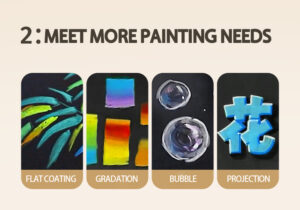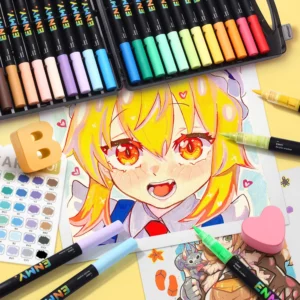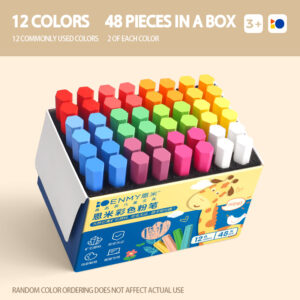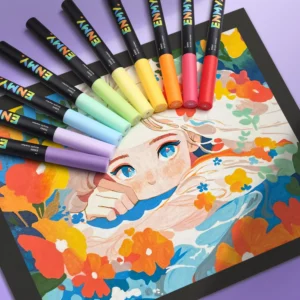When a child’s small hand holds a crayon for the first time and smears messy lines on the paper, they are not only creating colors but also quietly embarking on a wonderful journey of growth. Children’s painting is never just a simple “doodling”. Those seemingly immature brushstrokes hide the secret energy that promotes children’s physical and mental development.
A Playground for Imagination to Spread Its Wings
Painting is a “free kingdom” for children’s imagination. On the paper, a kitten can fly to the moon with wings, and a small fish can swim in the clouds wearing a hat. This kind of creation that breaks the rules of reality is the most precious form of imagination. Psychologists have found that children who often paint are better at putting forward novel ideas – when they draw a “singing house”, they will naturally think “should a microphone be installed on the roof” and “can the windows be used as speakers”. These whimsical associations will gradually turn into creativity for solving problems.
This kind of imagination can also help children understand abstract concepts. For example, when drawing “happiness”, some children will draw a sun with rainbow bubbles, and others will draw a group of people holding hands and turning around. They turn the invisible emotions into tangible images with specific pictures. This “materialization” ability is an important foundation for learning abstract subjects such as mathematics and science in the future.
A Secret Diary of Emotions
For children who have not yet mastered complex languages, the brush is the most honest “emotion expresser”. When angry, they may vigorously smear out black blocks, with lines as tight as small fists; when happy, the picture will be full of bright yellow and pink, and even the grass is dancing. Psychologists often analyze children’s psychological state through their paintings – a painting full of sharp lines and gray colors may hide the child’s anxiety; while the “mother’s hand” that repeatedly appears in the picture is full of desire for warmth.
Painting can also help children release pressure. When they are sad because of a quarrel with a friend, drawing a “reconciliation hug” or painting the unhappy things as a small black dot thrown into the trash can, their emotions will gradually calm down with the brush. This “visual catharsis” makes it easier for children to deal with complex feelings than verbal expression.
A Training Camp for the Tacit Understanding Between Small Hands and the Brain
The process of holding a pen, moving the pen, and controlling the strength is actually exercising the child’s “fine motor skills”. Drawing a straight line requires stable force from the wrist, and dotting a star requires controlling the weight of the fingers. These actions can promote the brain’s precise control of the fingers, laying a foundation for future skills such as holding a pen to write and using scissors. Studies have found that children aged 3-6 who often paint generally have better pen-holding postures and writing fluency.
At the same time, painting can also improve “spatial cognitive ability”. When a child decides to “draw the little rabbit on the grass and the sun in the upper right corner”, they are understanding the spatial relationship of “up, down, left and right”; when drawing a “three-layer cake”, they need to arrange the size and position of each layer. This grasp of spatial levels will quietly transform into geometric thinking and logical ability in mathematics.
A Colorful Magnifying Glass to Understand the World
Every stroke a child draws is an observation and understanding of the world. When drawing flowers, they will notice that “petals grow from the middle outwards”; when drawing cars, they will find that “wheels can roll only if they are round”. These observations are not passive seeing but active exploration – just like a little scientist doing experiments, they verify their cognition of the world through the brush: “It turns out that the sky is pink in the morning and purple in the evening” and “a dog’s ears will stick back when it runs”.
This kind of observation will make children more sensitive. Children who often paint can notice the texture of leaves and the change in the shape of clouds. This ability to capture details will make them love the small beauties in life more. When a child points to the “ants moving” on the painting paper and says “they are carrying bread crumbs bigger than themselves, which is amazing”, they have already learned to respect and understand life through painting.
A Growth Ladder for Self-Confidence
When a child completes a painting, even if it is just a crooked small house, they will gain a sense of accomplishment of “I did it”. This sense of accomplishment will germinate like a small seed – from “I can draw a straight line” to “I can draw an entire park”, every progress enhances their self-confidence. More importantly, there is no “standard answer” in painting, and children don’t need to worry about “drawing wrong”. This stress-free creative environment enables them to dare to try and not be afraid of failure.
When parents carefully listen to their children explain the stories in the paintings – “this is a magic tree that can cure diseases” and “this little man is a superman protecting the earth”, the children will feel that their ideas are valued. This sense of being recognized will make them more willing to express themselves and gradually grow into a person with their own opinions and courage to create.
The colors and lines flowing on the painting paper are actually the “invisible nutrients” for children’s growth. It allows imagination to grow freely, gives emotions an outlet, makes small hands more flexible, makes eyes more sharp, and makes the heart more confident. So, when a child runs to you holding a paint-stained painting, don’t rush to ask “what is this painting”, first listen to the story they tell – in those immature brushstrokes, there is something more important than “whether it looks like the real thing”, which is a small world that is booming.






